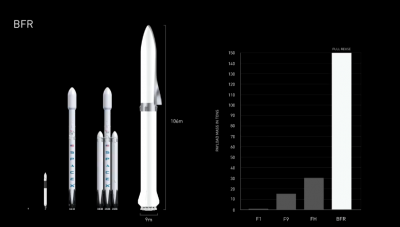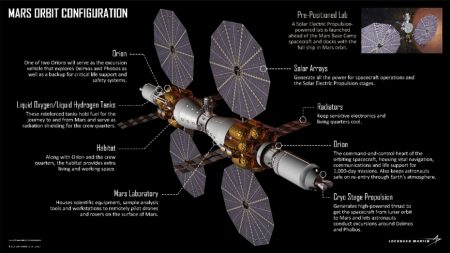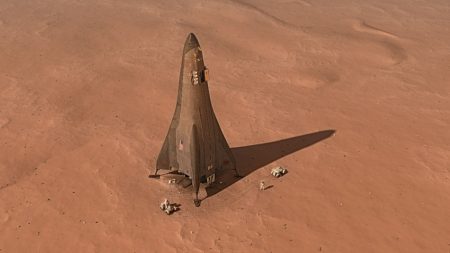September 29, 2017 – At the International Astronautical Congress in Adelaide, Australia, this week, SpaceX founder, Elon Musk, and one of his corporate rivals, Lockheed Martin unveiled their plans for the Red Planet. For Musk, his big reveal was a scale down of a previous proposal to fly enormous space transports to Mars to create a city of one million there by mid-century.
Mars 2022 and 2024 – Elon Musk’s BFR Reveal
Musk’s new vision is code named BFR. He intends to build and launch the first two of these new rockets in 2022, followed by four heading for Mars in 2024. The first two would be cargo ships. The next four would be split between cargo and passengers.
In his previous proposal unveiled at a similar event in Guadalajara, Mexico in 2016, Musk described the Interplanetary Transport System, a 90-meter tall, reusable ship that would operate on a 26-month cycle between Earth and Mars, when the two planets were best aligned.
The challenge to this idea was its sheer scale, very ambitious, and very expensive. Musk, at the time, described a private-public partnership as the means by which his Mars vision could be realized.
But in this new iteration, he is going smaller and plans to use the resources of SpaceX and its reusability paradigm to achieve his Martian dream. Everything in SpaceX current inventory, Falcon 9, Falcon Heavy, and Dragon, can be repurposed to achieve his 2024 timeline, Musk states. The first ships would carry a complement of 100 on board. Musk envisions 40 cabins, a large common area, central storage, a galley, and solar storm shelter for its human occupants.
Musk also believes that the BFR concept could serve Earth travel as well. At his presentation, he described how the rocket could provide sub-orbital transportation between any two points on Earth in 30 to 60 minutes. With 100% reusability, multiple redundancies for safety, and the expertise already gained from SpaceX increasing successes, Musk argues that the cost to provide these services beyond the fuel requirement and regular maintenance of the vehicle and launch facility will be minimal, like flying on any commercial aircraft today.
The BFR project, as Musk describes it, doesn’t need the private-public partnership of his previous Mars’ vision. He stated that the revenue SpaceX receives today from its Earth satellite launches, as well as the sub-orbital transportation business he envisions will make more than enough money to make the Mars project viable.

Lockheed Martin’s Red Planet Base Camp Plans
The company, that along with Boeing, has been NASA’s primary commercial supplier, was also in Adelaide, presenting a different vision from that of Musk and SpaceX. Lockheed Martin has its own plan to send humans to Mars in the 2020s. Instead of hundreds, the company sees a crew of between four and six making the trip.
Called Mars Base Camp, it involves several steps.
- Sending astronauts to a lunar-orbiting gateway
- Rendezvousing and assembling the components for the Mars trip at that locale
- Making the trip
- Rendezvousing with pre-positioned laboratory components in Martian orbit sent prior to the crew’s arrival.
Lockheed Martin claims to have all the technology at present needed to achieve the Base Camp mission which would utilize:
- NASA’s heavy-lift Space Launch System to deliver into Earth and lunar environments critical components for the mission
- Orion capsule, already flight tested and designed for long-duration life support, with deep space communications and navigation capability and tested Earth re-entry technology
- Deep Space Gateway project, the planned lunar orbital base containing the components needed for the similar Martian orbital base
- Advanced propulsion systems able to pre-position components in the Martian environment
- Prior experience in getting to Mars and landing on it successfully

The company envisions a three-year mission where its human crews would largely never step foot on Mars but rather would orbit the planet. The crews would send robotic landers and rovers to the surface to explore potential landing sites, discover areas where resources could be exploited, and pick up samples for analysis back in orbit. In a white paper the company has prepared, it describes side visits by astronauts to the Martian moons, Phobos and Deimos. It also introduces a reusable lander, seen in the illustration below, which would be able to descend with a crew of four to the surface and return for refueling in orbit. The lander would have sufficient life-support on board for missions lasting up to two weeks away from the Base Camp.

Lockheed Martin doesn’t speculate on how its Mars Base Camp will be funded. It more than likely sees NASA and its international space program partners coming up with the cash. Its project is very much in the tradition of NASA, focused on science and exploration.
Musk founded SpaceX, on the other hand with a mission to make the human species multi-planetary. Musk wants to settle us on Mars and eventually terraform it to make it our second home.
In his presentation in Adelaide, he talked about the red skies and blue sunsets of Mars, the opposite of what we see here on Earth. You can feel his passion and the sense of urgency he brings to this vision, far different from that displayed in the promotional-style video that accompanied Lockheed Martin’s presentation.
Will either of these two projects ever happen?
We saw humans land on the Moon from 1969 to 1972. It’s 45 years later and no humans have ventured beyond Earth orbit. Musk, in his presentation, asked why there is no human lunar presence today, no research station in orbit or on the surface. It’s a fair question and one that many who lived through the Apollo landings continue to ask.







